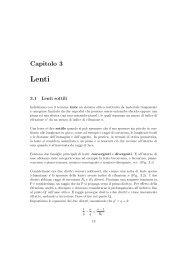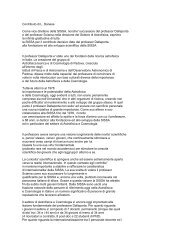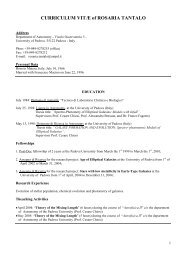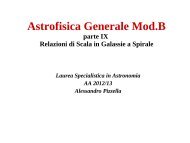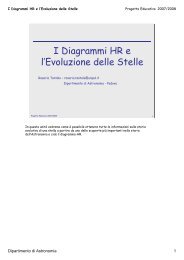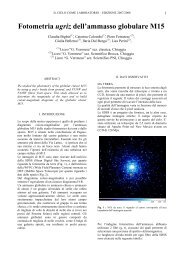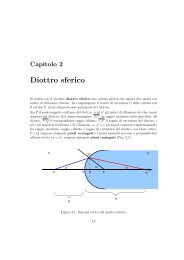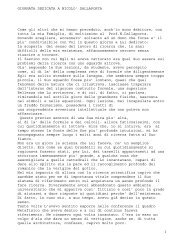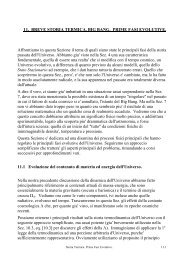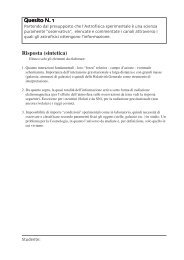Telescopi
Telescopi
Telescopi
You also want an ePaper? Increase the reach of your titles
YUMPU automatically turns print PDFs into web optimized ePapers that Google loves.
112 CAPITOLO 7. TELESCOPI<br />
b2 = − 2ff3 1<br />
(f − f1) 3 d −<br />
( f + f1<br />
f − f1<br />
vediamo che il primo termine è sicuramente negativo, il secondo è minore di 1 e quindi<br />
anche b2 < −1, cioè anche il secondario è iperbolico.<br />
Il telescopio che unisce primario iperbolico a secondario iperbolico fu ideato da George<br />
Willis Ritchey e Henri Chrétien (Fig. 7.7).<br />
Figura 7.7:<br />
Ipotizziamo che il telescopio di Asiago sia un Ritchey-Chrétien e calcoliamo le costanti<br />
delle coniche relative ai due specchi:<br />
) 2<br />
( ) 2<br />
600 − 372 600<br />
b1 = −1 − 2 = −1.30<br />
372 1200<br />
2 · 1200 · 6003<br />
b2 = − −<br />
372(1200 − 600) 3<br />
( ) 2<br />
1200 + 600<br />
= −15.45<br />
1200 − 600<br />
Si faccia attenzione al fatto che al fuoco primario questo telescopio non è esente da<br />
aberrazione sferica (B = 0)!<br />
Calcoliamo adesso il valore dell’astigmatismo.<br />
C = f1(f − d)<br />
2f 2 (f1 − d) −<br />
[<br />
b2 +<br />
C = f1(f − d)<br />
2f 2 (f1 − d) +<br />
= f1(f − d)<br />
2f 2 (f1 − d) +<br />
( ) ]<br />
2<br />
f + f1<br />
f − f1<br />
2ff3 1<br />
(f − f1) 3d (f − f1) 3 d 2<br />
8f 3 f 2 1 (f1 − d)<br />
(f − f1) 3d2 8f 3f 2 1 (f1 − d) =<br />
f1d<br />
4f 2 (f1 − d) = 2f1f − 2f1d + f1d<br />
4f 2 =<br />
(f1 − d)




